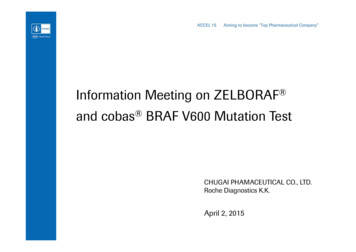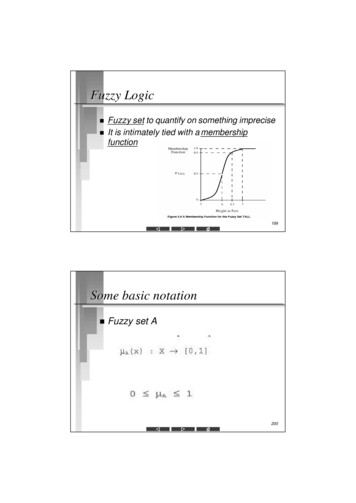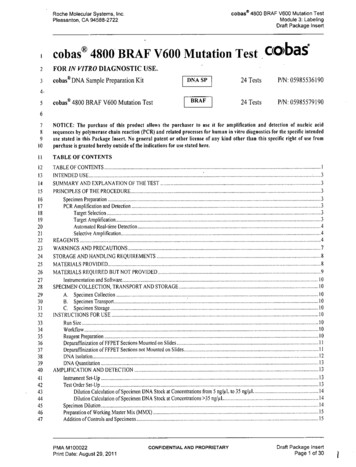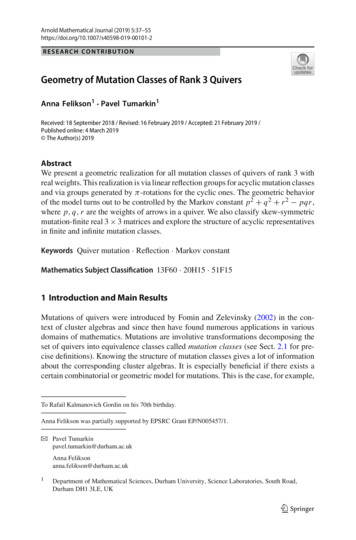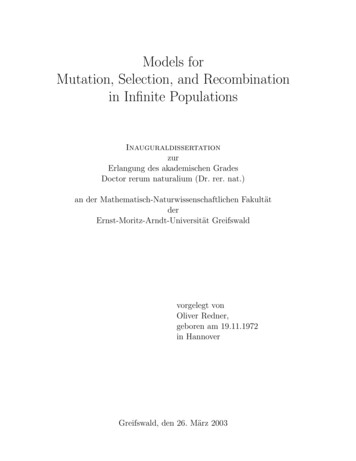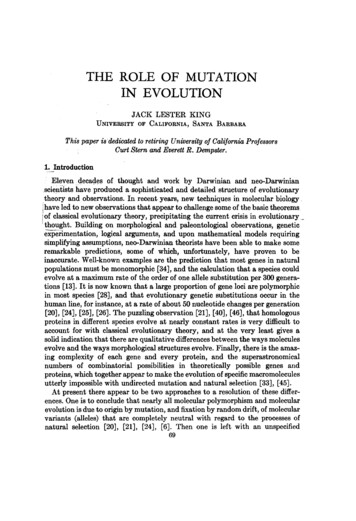
Transcription
THE ROLE OF MUTATIONIN EVOLUTIONJACK LESTER KINGUNIVERSITY OF CALIFORNIA, SANTA BARBARAThis paper is dedicated to retiring University of California ProfessorsCurt Stern and Everett R. Dempster.1. IntroductionEleven decades of thought and work by Darwinian and neo-Darwinianscientists have produced a sophisticated and detailed structure of evolutionaryand observations. In recent years, new techniques in molecular biology,theoryhave led to new observations that appear to challenge some of the basic theoremsof classical evolutionary theory, precipitating the current crisis in evolutionarythought. Building on morphological and paleontological observations, geneticexperimentation, logical arguments, and upon mathematical models requiringsimplifying assumptions, neo-Darwinian theorists have been able to make someremarkable predictions, some of which, unfortunately, have proven to beinaccurate. Well-known examples are the prediction that most genes in naturalpopulations must be monomorphic [34], and the calculation that a species couldevolve at a maximum rate of the order of one allele substitution per 300 generations [13]. It is now known that a large proportion of gene loci are polymorphicin most species [28], and that evolutionary genetic substitutions occur in thehuman line, for instance, at a rate of about 50 nucleotide changes per generation[20], [24], [25], [26]. The puzzling observation [21], [40], [46], that homologousproteins in different species evolve at nearly constant rates is very difficult toaccount for with classical evolutionary theory, and at the very least gives asolid indication that there are qualitative differences between the ways moleculesevolve and the ways morphological structures evolve. Finally, there is the amazing complexity of each gene and every protein, and the superastronomicalnumbers of combinatorial possibilities in theoretically possible genes andproteins, which together appear to make the evolution of specific macromoleculesutterly impossible with undirected mutation and natural selection [33], [45].At present there appear to be two approaches to a resolution of these differences. One is to conclude that nearly all molecular polymorphism and molecularevolution is due to origin by mutation, and fixation by random drift, of molecularvariants (alleles) that are completely neutral with regard to the processes ofnatural selection [20], [21], [24], [6]. Then one is left with an unspecified69
70SIXTH BERKELEY SYMPOSIUM: KINGminority of adaptive molecular changes which, one is free to hypothesize,behave exactly as dictated by established theory. As it happens, neo-Darwiniantheory itself has included the prediction that no genetic change can be selectivelyneutral, but upon close examination this idea, attributable largely to R. A.Fisher, is only an unsupported opinion.The second approach to attempting a resolution is to modify neo-Darwiniantheory to accommodate the new observations. An example of this approach is arejection of the mathematically simplifying assumption that minor deleteriouseffects are independent in action, and the substitute proposal that selection ongenes with such effects acts by simultaneously eliminating many deleteriousgenes with the genetic death of a few individuals that by chance exceed somethreshold level of deleterious effects (so-called truncation selection, see [22], [30],[53]). Such threshold effects are commonly encountered in developmentalgenetics studies, but at present the idea of a generalized threshold in fitness hasrather little observational support, either classical or molecular.There is no inherent contradiction in these two approaches, and both may bevalid. A synthesis of approaches may be most constructive. I think it somewhatunlikely that molecular polymorphisms and molecular amino acid substitutionsare each of two discrete classes, one due entirely to natural selection and theother due entirely to neutral mutation and random drift; rather, it is likely thatmutation, random drift, and natural selection are often (each to a greater orlesser degree in individual instances) important in molecular evolution and innatural variation on the molecular level.2. The role of mutation in evolution: the classical viewA few decades ago there was a lively controversy over the role of mutation inevolution. Did mutation have any directive influence on evolution? The controversy was resolved in favor of R. A. Fisher and other population genetics theorists, and until now evolutionary biologists have held the following opinionsvirtually unanimously.(a) There is always sufficient genetic diversity present in any natural population to respond to any selection pressure. Therefore actual mutation ratesalways are in excess of the evolutionary needs of the species.(b) There is no relationship between the mutation rate and the rate ofevolutionary change.(c) Because mutations tend to recur at reasonably high rates, any clearlyadaptive mutation is certain to already have been fixed. Therefore, naturalpopulations are at, or very near, either the best of all possible genetic constitutions, or an adaptive peak of genotype frequencies [56].(d) Since all possible adaptive mutations are fixed, and since neutral mutations are unknown, virtually all new mutations are deleterious, unless the environment has changed very recently. Even a recent change in the environmentdoes not make new mutations necessary, because of (a).
ROLE OF MUTATION IN EVOLUTION71(e) Evolution is directed entirely by natural selection, acting on geneticvariability that is produced by recombination, from "raw materials" producedby recurrent mutation a long time ago.(f) Mutation is random with respect to function.The remarkable thing about this consensus of opinion on the role of mutationin evolution is that it is generally true on the level at which it was formulated,namely, morphological and physiological evolution; at the same time, everystatement is untrue at the level of molecular change in evolution. Thus, as wehope to document in the remainder of this paper:(a) most specific allelic states achievable by even the simplest and mostcommon form of mutation-single nucleotide substitution-are highly unlikelyto be present within a species at any point in time;(b) there is a simple and direct relationship between the mutation rate andthe rate of evolutionary change on the molecular level;(c) specific mutations do not recur at reasonably high rates; a species mayhave to wait millions of years before a specific adaptive mutation occurs andbegins to increase toward fixation;(d) an evolutionarily significant proportion of new mutations are eitherneutral or very slightly advantageous;(e) an increased mutation rate may be beneficial to a population or a species;(f) mutation is not random with respect to function on the molecular level.Let us look first into the question of recurrent mutation. To do this adequately,we must first determine the fundamental mutation rate.3. The fundamental nucleotide substitution mutation rateThere are many classes of mutation that are evolutionarily significant. On themolecular level, these include deletions, insertions, gene duplications, andnucleotide substitutions, the last sometimes but not always resulting in aminoacid substitutions. Nucleotide substitutions are the most common kind of mutational event and the most common kind of evolutionary change. What is themutation rate, in humans, of nucleotide substitutions? I shall present four independent estimates of this rate, all quite consistent.3.1. The rate of DNA divergence. Kohne [25], [26] finds that the differencein mean melting point temperature between native DNA and human-greenmonkey hybrid DNA (after the removal of redundant sequences) is 7.0 C,corresponding to approximately 10.5 per cent nonhomology of nucleic acid sites.If the last common ancestor of the old world monkeys and the hominid linelived 30 million years ago [46], [47], the mean rate of evolutionary substitutionin primate unique sequence DNA is approximately 18.4 X 10-10 substitutionsper nucleotide per year in each line of descent. DNA hybridization studiesbetween man and new world monkeys, and between new world monkeys and oldworld monkeys, indicate an average of 18.0 per cent nonhomology; usingSarich and Wilson's estimate of 50 million years since the last common ancestor
72SIXTH BERKELEY SYMPOSIUM: KINGof new world monkeys, old world monkeys, and man, this gives a very similarnucleotide substitution rate of 19.8 X 1O- per nucleotide per year (allowingfor repeated changes at some sites).This evolutionary rate of nucleotide substitution per species is almost certainlyvery close to the nucleotide substitution mutation rate per gamete. This isbecause most nucleotide substitutions in total DNA are probably selectivelyneutral, and the evolutionary rate of selectively neutral substitutions per speciesis the same as the mutation rate for neutral mutations per gamete, as has beenshown elsewhere [20], [24]. Reasons have also been given elsewhere [24], [21]for the conclusion that more than 99 per cent of all mammalian DNA is nongenetic in the sense that all point mutations occurring within that portion areselectively neutral. This DNA does not code for protein and appears to have noknown function. Kohne [25], [26] provides a further convincing argument bypresenting evidence that most "unique sequence" DNA appears in fact to bethe degenerate remains of past "repeated sequence" families, the members ofwhich have lost detectable homology because of random divergence. If mostrandom divergence in DNA is not subject to natural selection, the fundamentalnucleotide substitution mutation rate is approximately 19 X 10-10 per nucleotideper genome per year.3.2. Measured mutation rate8 for human genetic pathologies. For decadesgeneticists have measured "recurrent" mutation rates in many species, includingman. Generally these mutations have been recurrent only in that they occur inthe same gene and tend to inactivate it; on the molecular level, many differentmutations may cause gene inactivation, while other mutations occurring withinthe cistron may go undetected. A reasonable estimate of the average mutationrate of lethal or visible mutations per cistron for human pathologies is about10-6 per generation [51]. This is a lower figure than is usually reported. Since Iwish to show that the mutation rate for specific changes is very low, let usconservatively take a higher (but still reasonable) mutation rate of 5 X 10-6 pergamete per generation. For the basic nucleotide substitution rate, however, weneed somewhat different information. The only experimental basis for translatinglethal mutation rates into estimated nucleotide substitution rates is providedby the work of Ames [1] and Whitfield, Martin, and Ames in Salmonella [55].They found that only ten per cent of mutations known to occur in the histidineloci investigated were recoverable as lethals; the remainder, all base substitutions, either had no effect or only partially inactivated the gene loci and hencewere unrecoverable in their test situation. The general conclusion is that adetectable mutation rate of 5 X 10-6 implies a nucleotide substitution rate ofabout 5 X 10-6 per cistron per generation. Taking the mean generation timeto be 25 years and a representative cistron size of 1000 nucleotides, this givesan estimated nucleotide substitution rate of 20 X 10-10 per year.3.3. Concomitantly variable codons in cytochrome c. Fitch and Markowitz [11]observed that calculations of the probable number of potentially variable sitesin the evolution of cytochrome c depended on the evolutionary time span
ROLE OF MUTATION IN EVOLUTION73covered. As they consider groups of animals more closely related in evolutionarytime, the estimated number of potentially variable codons decreases in a regularway (Figure 1). The regression line, extrapolated to zero, indicated to Fitch andMarkowitz that only ten per cent of cytochrome c's 104 codons were free to varyin one species at one point in time. King and Jukes [24] estimated the evolutionary rate of cytochrome c in mammals to be about 4.3 X 10-' amino acidsubstitutions per codon per year; if Fitch and Markowitz are correct, this is theequivalent of 43 X 10 10 amino acid substitutions per variable codon per year.Allowing for three nucleotides per codon, and for the fact that about one fourthof nucleotide substitutions within codons do not change amino acids, the calculated rate of change for nucleotides free to vary in the cytochrome c cistron is43 X 4/3 X 1/3 X 10-10 19 X 10-10 per nucleotide per year. This is nearlyidentical with previously calculated rates, indicating that variable codons incytochrome c vary at the mutation rate; this may be taken as circumstantialevidence favoring the possibility that mutations in the variable codons areneutral and that nearly all cytochrome c evolution in mammals may have beendue to mutation and random drift.King and Jukes [24] suggested earlier that 9/10 of cytochrome c mutations areselected against. They calculated that fibrinopeptide A in mammals evolved atthe rate of 43 X 10-10 per codon per year, the equivalent of 19 X 10-10 pernucleotide per year and ten times the rate of change of cytochrome c. This wouldappear to indicate that nearly all of the fibrinopeptide A codons are free to vary,a conclusion also reached by Fitch on different grounds. Estimates of theevolutionary rate of the fibrinopeptides are probably not too reliable, however,because of the numerous evolutionary gaps and insertions and the consequentambiguity in homology, and as pointed out previously [24], portions of thefibrinopeptide molecule tend to be relatively conservative, presumably becauseof selective restraints [3], [4]. Even so, the consistency of these comparisonstends to support the estimated annual nucleotide mutation rate of 19 X 10-10.3.4. Estimates based on human hemoglobin variants. An upper limit on thefundamental base substitution rate can be derived from the frequencies of humanhemoglobin electrophoretic variants. These are found among Northern Europeans at the frequency of about 5 X 104 per individual, or about 2.5 X 10-4per haploid genome (both alpha and beta chains together). Not all these variantsrepresent new mutations, of course. Motulsky [35] states that considerablyfewer than ten per cent of all carriers have both parents unaffected-that is,considerably fewer than ten per cent carry new mutations. Motulsky assumesthat the proportion of carriers with new mutations is between 0.4 per cent and4 per cent; if so, the mutation rate per gamete for electrophoretic variants isthen between 10-6 and 10-6 for the combined alpha and beta chain cistrons.Only about one fourth of all amino acid substitutions, and only about 3/16 of allnucleotide substitutions, result in electrophoretically detectable protein changes.There are 861 nucleotides in the two cistrons; the human generation span isabout 25 years; so, for the annual nucleotide mutation rate the above range
74SIXTH BERKELEY SYMPOSIUM: KING100zFEGzGwZ 60CDI4L. DH-C \I0I-zw0cr40a.RN O SPC IEL-A20203040RANGE OF SPECIES(REQUIRED NUCLEOTIDE REPLACEMENTS)10FIGURE 1The number of invariant positions in cytochrome c can be estimated from theapproximation of the distribution of evolutionary changes among variablepositions to modified Poisson distributions. The calculated number of invariantpositions is a function of the evolutionary distance between species compared;extrapolating back to zero, Fitch and Markowitz [11] concluded that only tenper cent of the amino acid positions in cytochrome c are free to vary in onespecies at any one point in time. This corresponds well with the observation thatmammalian cytochrome c evolves at a rate equalto ten per cent of the mutation rate.
ROLE OF MUTATION IN EVOLUTION75should be divided by 3/16 X 861 X 25. The range of likely mutation rates pernucleotide per year is thus between 2.5 X 10-10 and 25 X 10-10, with an averageestimated value of 13.75 X 10-10. This is not very different from the otherestimates. The principal uncertainty is in the actual proportion of varianthemoglobin carriers lacking a carrier parent. A prediction can be made: since thebasic nucleotide substitution rate appears to be approximately 19 X 10-10 peryear, the proportion of variant hemoglobin carriers with both parents normalwill be approximately three per cent.The approximate agreement of these four estimates indicates that the annualnucleotide mutation rate in humans is probably close to 19 X 1O" . Furthermore, this internal consistency tends to confirm the original contention thatmost mammalian DNA is not functioning as genetic material: the total evolutionary rate of DNA is approximately equal to what has been found, by othermethods, to be the fundamental nucleotide mutation rate. This indicates thatmost DNA is not subject to restraints of natural selection.3.5. The mutaion rate as a function of astronomical time. Kohne's DNAhybridization studies [25], [26] show that the DNA divergence rate is about thesame in the two lines connecting humans and old world monkeys with the moredistantly related capuchin: the DNA melting temperature depression forhuman-capuchin hybrid DNA is 11.60C, while that for green monkey-capuchinhybrid DNA is 12.30C. The difference between these two values is close to thelimit of resolution of the experimental procedure. The melting point depressionfor man-green monkey hybrid DNA is 7.00C; the three values together indicatethat the human line has diverged 3.15 C and the old world monkey line hasdiverged 3.85 C from their common ancestor. Taken at face value, this meansthat the human line has evolved at an average rate about 18 per cent slower thanthe monkey line. However, similar comparisons between the chimpanzee andthe rhesus indicates that, since the same common ancestor, the chimp hasdiverged 3.250C and the rhesus has diverged 3.550C, a rate difference of onlyeight per cent. Both chimpanzees and humans have long average generationspans relative to those of monkeys, so the indication is that the DNA evolutionary rate is not closely related to generation span. The further inference is thatthe DNA base substitution mutation rate is approximately constant withastronomical time.Other papers presented at this conference [6], [21] document the generalobservation that the evolutionary rates for homologous proteins appear to benearly constant with time in different vertebrate lines of descent, despite widevariations in rates of morphological evolution, in population size, and in meangeneration spans. The simplest explanation is that the rate of molecular evolutionis directly related to the mutation rate, and that the mutation rate is constantper unit time in any one species and very similar in different vertebrate species.It has been suggested by various investigators that mutation might be a directfunction of the number of generations (meioses) or of the number of cell generations (mitoses). There is little evidence to support either of these opinions. It is
76SIXTH BERKELEY SYMPOSIUM: KINGtrue that the mutation rate is nearly proportional to the number of cell generations in very rapidly dividing bacteria [29], but it quickly becomes a linearfunction of astronomical time in somewhat more slowly dividing bacteria [38]and continues to occur at a fairly high rate in bacteria that are not dividing atall [43], [44]. Cells in vertebrate germ line probably divide less than once amonth on the average, and most of the mutations that occur are probablyunrelated to DNA replication or cell division. The mutation rate in storedDrosophila sperm is exactly the same, per unit time, as the rate in rapidlydeveloping larvae and pupae [16]. Mutations also occur in stored fungal sporesat an approximately constant rate [54]. Until contrary evidence is presented, onemust suspend any hypotheses of any direct relationships between mutation andeither generation number or cell generation number.Mutation rates per unit time do differ greatly in very distantly related lifeforms. Ryan [43], [44] calculated the mutation rate for autotrophy in nondividing histidine minus E. coli to be 1.2 X 10-9 per hour. This gives an annualmutation rate of 10- for histidine reversions. If one estimates (generously) thatten different specific mutations would lead to histidine reversion, the annualmutation rate for specific mutations in E. coli is about 10-6, compared with anannual rate of 6 X 10-' for specific mutations in humans. Thus, there appearsto be a difference of at least a thousandfold in the mutation rates per unit timein these two life forms. Similarly, there is unquestionably a large discrepancybetween the mutation rates per unit time in man and in Drosophila. The meanrate of lethal mutation per gene per generation is about 3 X 10-1 [37]; assumingthat the rate of base substitutions per locus is ten times greater, that the averagegene size is 1000 nucleotides, and that the average generation time in Muller's experiments was two weeks, the per-nucleotide annual mutation rate in Drosophilais estimated to be 3 X 10-5 X 10-3 X 25 7.5 X 10-7, more than 300 timesgreater than the annual mutation rate for humans estimated by means of approximately the same procedure. The mutation rate per locus per generation is aboutthe same in both species, but there is about five hundredfold difference ingeneration spans.3.6. Evolutionary rates in insects and mammals. This presents a conundrum,first pointed out to me by J. F. Crow. In the 103 positions of cytochrome c thatare homologous in all three species, the number of amino acid differences betweenwheat and human is 34, while the number of differences between wheat andfruit fly is 42. Considering the large difference in annual mutation rates, whyhave the two animal species diverged so nearly the same distance from the plantspecies? The question is not easily answered; however, the difficulty may not beso great as it first appears. The corresponding number of differences betweenman and fly is 24. If one subtracts the (approximately) 30 invariable sites from103, and makes a first order correction for multiple changes at individual sitesby estimating the frequency of changes per variable site from the negative logof the proportion of variable sites unchanged [24], [40], the estimated number ofevolutionary substitutions between man and fly is 29; between man and wheat,
ROLE OF MUTATION IN EVOLUTION7746; between fly and wheat, 63. These corrections are known to be inadequate,since they assume that all variable sites are equally variable; the real numbers ofevolutionary events must be greater and the proportional differences betweenthem much greater. But if one accepts provisionally the evolutionary distancesof 29, 46, and 63, the calculated number of evolutionary steps since the flyhuman divergence would be only six in the human line and 23 in the fly line,indicating an evolutionary rate difference of 400 per cent. The complete inadequacy of these estimates is made evident by the fact that more than sixevolutionary substitutions are almost certain to have occurred in the humanline in just the last 100 million years or less, which is a small fraction of the totaltime since the human-fly divergence. Also, well more than! 12 changes appear tohave occurred in the human line since the fish-tetrapod divergence. With distantcomparisons of homologous proteins, such as those between kingdoms andbetween major phyla, it is virtually impossible to translate amino acid differences into rates of evolutionary change. Too much information is lost and obscured by sequential changes at sites with very different intrinsic rates of change,as well as by the wholly coincidental identity of some sites in different species.Fitch and Markowitz [11] emphasize that a large proportion of the cytochromec molecule is invariant among mammals, and a different but also large proportionis invariant among insects. Perhaps it is not impossible that cytochrome c hasin fact been undergoing amino acid replacements at a 300-fold greater rate ininsects than in mammals during the last 100 million years, if these changes occuronly in restricted portions of the molecule in each group.4. The specific mutation rateEach nucleotide in DNA can mutate to each of three other nucleotides. Thus,if the fundamental base substitution rate is approximately 19 X 10-10 pernucleotide per year, the mutation rate of specific mutations is one third of this,or about 6 X 10-10 per year. This rate is so low that it is almost nonsensical toconsider recurrent mutations to specific alleles to be evolutionarily significant.It is also nonsensical to consider back mutation rates to specific alleles [21], [40].Each amino acid specifying codon, on the average, can mutate to codons specifying approximately seven other amino acids. A gene coding for 287 amino acidsthe size of the hemoglobin alpha and beta chains together-can mutate to 2000other states by single base replacement, each mutation occurring at the samerate of approximately six per ten billion per genome per year. New mutationsrarely persist more than a very few generations [7]. It is therefore extremelyunlikely, even in a very large population (of mammals, at least) that even onecopy of a specific mutant form would be present at any given point in time. Itis quite false to suppose that the requisite genetic variability is present to meetevery evolutionary need; if one conceives of evolutionary needs in terms ofspecific molecular changes.A species of one million individuals would have to wait almost a thousand
78SIXTH BERKELEY SYMPOSIUM: KINGyears before a specific adaptive mutation would occur by mutation in just onemember. But even then the mutant allele would probably be lost; the probabilityof fixation of a beneficial mutation is less than twice its selective advantage, ormore specifically, 28(Ne/N) where s is the relative selective advantage, N is theactual size of the population, and N. is the effective size of the population aftercertain adjustments are made for sex ratio, temporal fluctuations, and variationsin fecundity [17], [7]. The Ne/N for a species over evolutionary time may be afairly small number, because of such likely events as the expansion of smallpopulation isolates and the displacement and extinction of competing isolates.A species with an evolutionarily effective population size of 106 would have towait, on the average, 40 million years before a specific mutation with a selectiveadvantage of 10-4 would occur and begin to increase toward fixation. A specieswith an effective size of one million-and an actual population size perhapsmany times as large-would only have to wait an average of four million years!In either case, it is highly likely that the environment, the background genotype,and perhaps even other codons in the same cistron would have changed meanwhile, and with them the selection coefficient.If this can be said to be an evolutionary mechanism at all, it is surely a veryinefficient one. Some species are very much larger than one million in size-someinsect species, for example-and for these it might be true that all possiblesingle step mutant alleles are always present and that any possible advantageousmutations will be ready to compete in any new situation, the most fit eliminatingall others. But other species have small populations and evolve just the same.The basic observations that led to the conclusion that genetic variability isalways present are that artificial selection on previously unselected metric traitsis always successful, and that canalized traits can often be shown to conceal alarge amount of potential genetic variability. That is to say, the genetic variability is there all right, when measured through its effect on morphology andphysiology; but one cannot extrapolate from gross morphology to molecularstructure and expect the same relationships to hold. Only a tiny fraction of thegenetic variability potentially available by mutation is actually present in aspecies at any one time, and this fraction rapidly turns over, to be replaced byanother array of genuinely rare mutant alleles. Yet this changing small sampleof the genetic potential provides all the raw material for the adaptive (as well asneutral) evolution of protein molecules.It is not known how much of the genetic variability that is uncovered byselection experiments is due to variation in protein specifying structural genes.It seems plausible that the genes that control rates of synthesis and developmental patterns are more important in response to artificial selection, and arealso responsible for nearly all of the adaptive evolution of the kind usuallyconsidered [50]. Not much is known about controlling genes in higher organisms,but they are made of DNA, and the mutation rate considerations and the rarityof mutations to specific allelic forms must be the same for controlling genes asfor protein specifying genetic material. On the other hand, adaptive evolution
ROLE OF MUTATION IN EVOLUTION79must occur in structural genes also, as proteins do appear to be highly adaptedto their specific functions. But the mode and tempo of molecular adaptationmay be very different from that of morphological evolution. While it is certainlywrong to conclude that the genetic variability required to make specific molecularchanges is always present in the population, there are definite relationshipsbetween available genetic variability and the patterns of molecular evolution.It is because natural selection acts immediately and largely deterministically onthe morphological and physiological level that it acts stochastically and quasirandomly on the molecular and genetic level.6. The beneficial role of mutation in evolutionWhen it was believed that there was always ample genetic variability to meetev
Areasonable estimate of the average mutation rate of lethal or visible mutations per cistron for humanpathologies is about 10-6 pergeneration [51]. Thisis a lowerfigure thanis usually reported. Since I wish to show that the mutation rate for specific changes is very low, let us conservativelytakeahigher (butstill reasonable) mutationrateof5 X10 .



